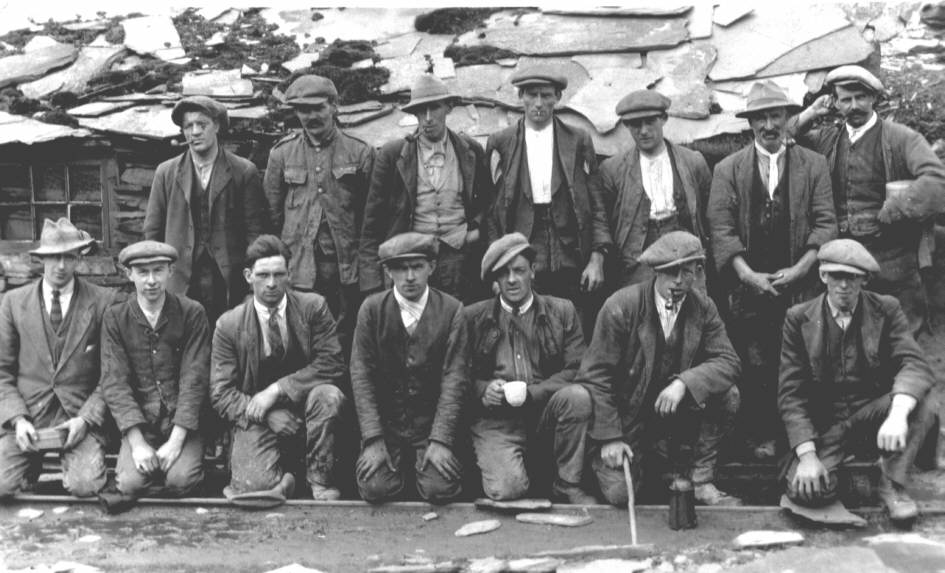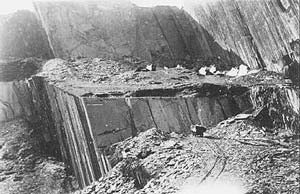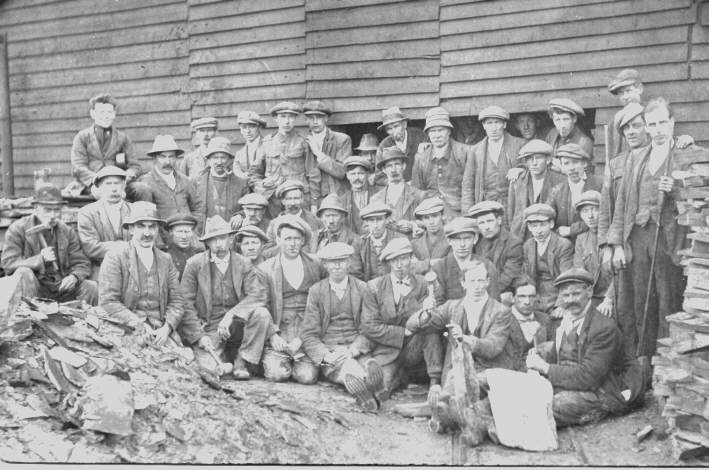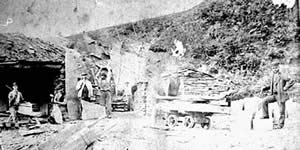Mining and
Quarrying
 It
is possible that lead was mined in the area around Llangollen
as far back as Roman times. Certainly in 1696 Edward Lhuyd,
in his travels around the area, said that lead was “previously
mined at Fron Lwyd” in the Eglwyseg Valley. Mining leases
from the 18th century show lead, copper, calamine, coal and
other ores being mined. It
is possible that lead was mined in the area around Llangollen
as far back as Roman times. Certainly in 1696 Edward Lhuyd,
in his travels around the area, said that lead was “previously
mined at Fron Lwyd” in the Eglwyseg Valley. Mining leases
from the 18th century show lead, copper, calamine, coal and
other ores being mined.
Slate too has been quarried since before
1700. The Clogau Quarry was established in 1690 and Edward
Lhuyd recorded hearing blasting from the Moel y Faen Quarry
in 1696 and refers to slate being sent from the Oernant Quarry
to the next county. Other quarries, such as the Aber Gwern
Quarry, the Eglwyseg (Pant Glas) Quarry, the Wynnstay Quarry
and the Ffynnon y Gog Quarry all operated in the 18th and
19th centuries.
Work started at 7.30am and was physically
hard. It could take up to 8 hours to hand drill a single hole
for a blasting charge. Breakfast was usually porridge and
bread - cheese and ham made up dinner. Quarrymen brought their
own tea and sugar in small tins. The day finished at 5.30pm
and was often followed by a long walk home. Wages in 1800
were 6 shillings (30 pence) per week.
|
 top of page top of page |
 The Berwyn Slate Quarry
The Berwyn Slate Quarry
The Berwyn Slate Quarry was opened as the
Clogau Quarry in 1690 and belonged to the Wynnstay Estate.
The quarry was, and still is, used to produce large slabs,
for hearths, worktops, tombstones and billiard tables.
The large blocks were transported to the
slate works at Pentrefelin (see map right) and, after finishing,
were loaded onto canal barges, and later railway freight cars,
for transport.
|

At the height of its operations the quarry
employed several hundred men. Purchased from the Wynnstay
Estate in 1950, the quarry today employs 4 men. |
  top of page top of page |
|
Opened around 1700, a
map from 1868 shows the Moel y Faen Quarry belonging to the
Wynnstay Estate. Producing mainly roofing slates the quarry
employed over 600 men at the height of its activity in 1871.
On the right are shown quarry workers at the Moel y Faen
quarry in 1923. By 1931 the number had dwindled to 126, but
the quarry continued to operate for another 20 years.
|
  top of page top of page |
|
The Rhiw Goch Quarry
in Rhewl was once a major employer in the area. By the 1880s
there were only 6 rockmen living in Rhewl and they were not
necessarily working at the Rhiw Goch. The quarrymen had to
collect their wages from the Bull Inn in Llangollen. Having
walked sometimes up to 5 miles home they would have a meal and
then walk another round trip of 6 miles to Llangollen and back
to get their money.
In later years when the quarry propspered
transport appeared on the scene and men were taken to
whichever quarry they worked at. |
  top of page top of page |
|
The Pant Glas slate quarry is marked on the
1844 tithe map as a wooded area called Caer Pistyll (Field
of the Waterfall). The quarry must have opened soon after,
however, as a map from the middle of the 19th century shows
a proposed tramway to link the Pant Glas Quarry with the Clogau
tramway.
The tramway was never built, but old photographs
(see right) show the quarry still in operation in 1881. |
| |
|
 The quality of the slate in this quarry was
poor, and the men found it difficult to make a living. At
the start of the 20th century they began to leave, and by
1930 the quarry was in crisis. However, a Manchester gentleman
took it over and the quarry expanded again, employing up to
thirty men. The quarry was worked in a different way and produced,
so it was said, the best slates in the country. Two years
later the owner was taken ill and died, causing the quarry
to close. The photograph shown here was taken in 1934 and
must have been shortly before the closure of the quarry. The quality of the slate in this quarry was
poor, and the men found it difficult to make a living. At
the start of the 20th century they began to leave, and by
1930 the quarry was in crisis. However, a Manchester gentleman
took it over and the quarry expanded again, employing up to
thirty men. The quarry was worked in a different way and produced,
so it was said, the best slates in the country. Two years
later the owner was taken ill and died, causing the quarry
to close. The photograph shown here was taken in 1934 and
must have been shortly before the closure of the quarry.
|
   top of page top of page |
|
|
 It
is possible that lead was mined in the area around Llangollen
as far back as Roman times. Certainly in 1696 Edward Lhuyd,
in his travels around the area, said that lead was “previously
mined at Fron Lwyd” in the Eglwyseg Valley. Mining leases
from the 18th century show lead, copper, calamine, coal and
other ores being mined.
It
is possible that lead was mined in the area around Llangollen
as far back as Roman times. Certainly in 1696 Edward Lhuyd,
in his travels around the area, said that lead was “previously
mined at Fron Lwyd” in the Eglwyseg Valley. Mining leases
from the 18th century show lead, copper, calamine, coal and
other ores being mined.



 The quality of the slate in this quarry was
poor, and the men found it difficult to make a living. At
the start of the 20th century they began to leave, and by
1930 the quarry was in crisis. However, a Manchester gentleman
took it over and the quarry expanded again, employing up to
thirty men. The quarry was worked in a different way and produced,
so it was said, the best slates in the country. Two years
later the owner was taken ill and died, causing the quarry
to close. The photograph shown here was taken in 1934 and
must have been shortly before the closure of the quarry.
The quality of the slate in this quarry was
poor, and the men found it difficult to make a living. At
the start of the 20th century they began to leave, and by
1930 the quarry was in crisis. However, a Manchester gentleman
took it over and the quarry expanded again, employing up to
thirty men. The quarry was worked in a different way and produced,
so it was said, the best slates in the country. Two years
later the owner was taken ill and died, causing the quarry
to close. The photograph shown here was taken in 1934 and
must have been shortly before the closure of the quarry.